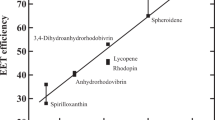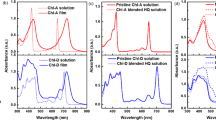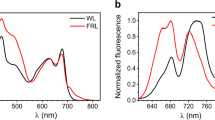Abstract
Photochemical transmembrane electron transfer processes are an integral part of natural photosynthetic solar energy conversion and are also central to the design of biomimetic energy conversion schemes1–6. Here we report the synthesis and membrane-associated photoelectrochemical properties of carotenoporphyrin–quinone triad (I), a compound containing a photochemically active porphyrin and electron donor and acceptor moieties, and with the molecular architecture necessary to span a phospholipid bilayer. On excitation of compound 1 by visible light, charge is separated across a planar phospholipid bilayer membrane (BLM) in an intramolecular step; in the presence of suitable electron donor and acceptor species in the aqueous phases, a steady-state photo-current is observed in an external circuit bridging the BLM. Artificial membranes containing I thus mimic key features of the photodriven transmembrane electron transfer processes characteristic of photosynthetic organisms.
This is a preview of subscription content, access via your institution
Access options
Subscribe to this journal
Receive 51 print issues and online access
$199.00 per year
only $3.90 per issue
Buy this article
- Purchase on Springer Link
- Instant access to full article PDF
Prices may be subject to local taxes which are calculated during checkout
Similar content being viewed by others
References
Dutton, P. L., Prince, R. C. & Tiede, D. M. Photochem. Photobiol. 28, 939–949 (1978).
Sauer, K. Acc. chem. Res. 11, 257–264 (1978).
Mathis, P. & Paillotin, G. in The Biochemistry of Plants Vol. 8 (eds Hatch M. D. & Boardman, N. K.) 97–161 (Academic, New York, 1981).
Calvin, M. in Photochemical Conversion and Storage of Solar Energy (ed. Connolly, J.) 1–26 (Academic, New York, 1981).
Porter, G. Proc. R. Soc. A362, 281–303 (1978).
Barder, J. Photosynthesis in Relation to Model Systems (Elsevier, New York, 1979).
Moore, T. A. et al. Nature 307, 630–632 (1984).
Gust, D. et al. Photochem. Photobiol 37 S, S46 (1983).
Moore, T. A. et al. Adv. Photosynthesis Res. 1, 729–732 (1984).
Gust, D. & Moore, T. A. J. Photochem.(in the press).
Gust, D. et al. J. Am. chem. Soc.(in the press).
Chachaty, C. et al. Org. magn. Reson. 22, 39–46 (1984).
Bienvenue, E., Seta, P., Hofmanova, A., Gavach, C. & Momenteau, M. J. electroanalyt. Chem. 162, 275–284 (1984).
Fettiplace, R., Andrews, D. M. & Hayden, D. A. J. Membrane Biol 5, 277–296 (1971).
Mathis, P., Butler, W. L. & Sato, K. Photochem. Photobiol 30, 603–614 (1979).
Bensasson, R. V. et al. Nature 290, 329–332 (1981).
Author information
Authors and Affiliations
Rights and permissions
About this article
Cite this article
Seta, P., Bienvenue, E., Moore, A. et al. Photodriven transmembrane charge separation and electron transfer by a carotenoporphyrin–quinone triad. Nature 316, 653–655 (1985). https://doi.org/10.1038/316653a0
Received:
Accepted:
Published:
Issue Date:
DOI: https://doi.org/10.1038/316653a0
This article is cited by
-
Evolution of reaction center mimics to systems capable of generating solar fuel
Photosynthesis Research (2014)
-
Conversion of light energy to proton potential in liposomes by artificial photosynthetic reaction centres
Nature (1997)
-
Photoinduced electron transport across a lipid bilayer mediated by C70
Nature (1993)
Comments
By submitting a comment you agree to abide by our Terms and Community Guidelines. If you find something abusive or that does not comply with our terms or guidelines please flag it as inappropriate.



